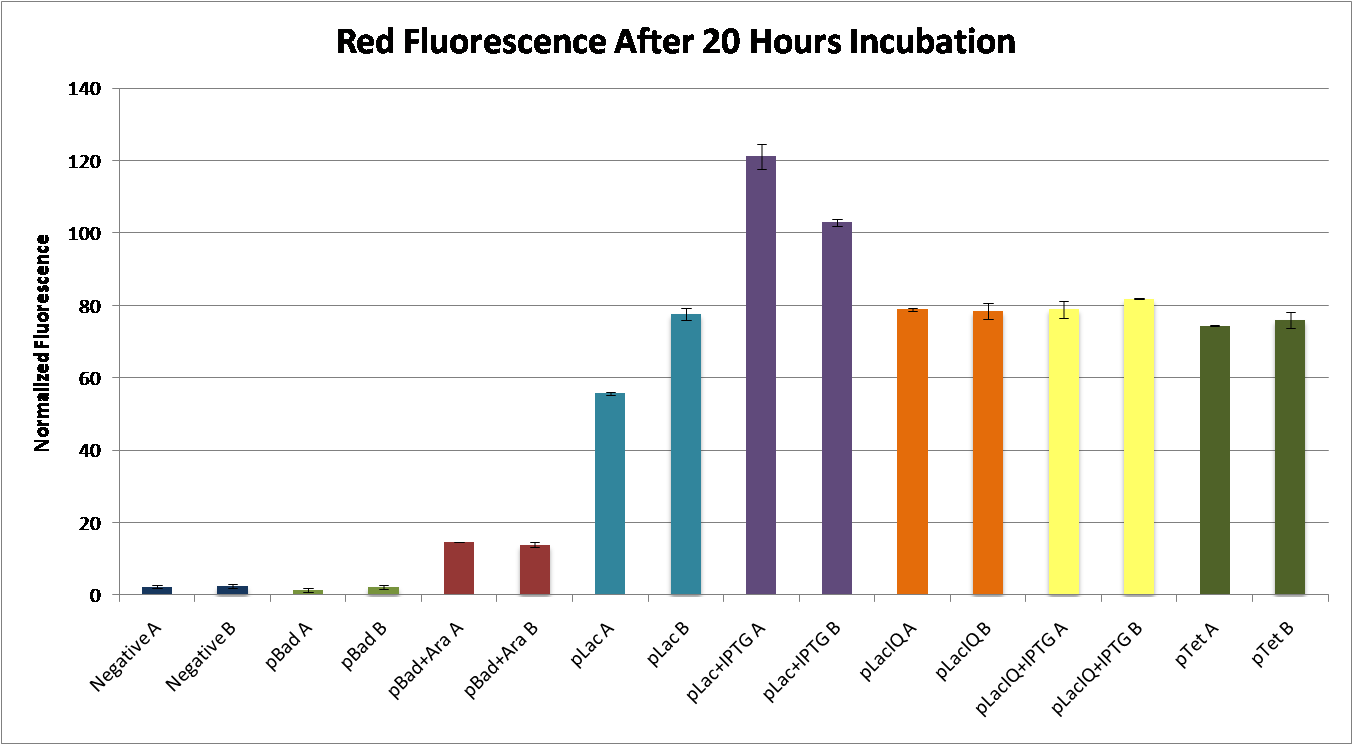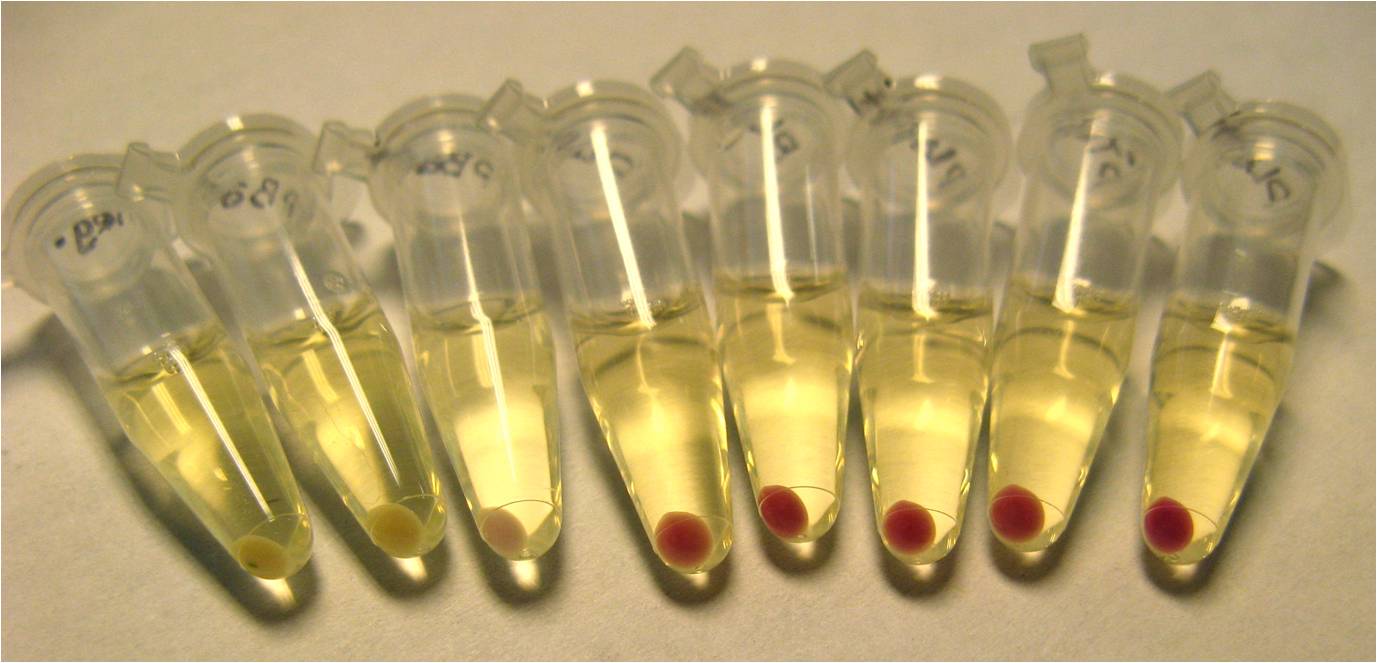Team:MoWestern Davidson/project wetlab
From 2009.igem.org
(→Choosing A Promoter) |
|||
| Line 1: | Line 1: | ||
{{Template:MoWestern_Davidson2009}} | {{Template:MoWestern_Davidson2009}} | ||
| - | + | =Completed tRNAs= | |
We assembled the genes for our suppressor tRNAs by ligating single-stranded oligos with sticky BioBrick ends. This generated double-stranded DNA ready to ligate into a standard vector. The expected size of our tRNAs with BioBrick ends is 184 bp. '''Below is a 2% agarose gel of plasmids containing our tRNA insert, digested with EcoRI and PstI:''' | We assembled the genes for our suppressor tRNAs by ligating single-stranded oligos with sticky BioBrick ends. This generated double-stranded DNA ready to ligate into a standard vector. The expected size of our tRNAs with BioBrick ends is 184 bp. '''Below is a 2% agarose gel of plasmids containing our tRNA insert, digested with EcoRI and PstI:''' | ||
| Line 61: | Line 61: | ||
[[Image:Reporter tRNA with 1 Promoter.png|none|500px]] | [[Image:Reporter tRNA with 1 Promoter.png|none|500px]] | ||
| - | == '''Choosing A Promoter''' == | + | =='''Choosing A Promoter'''== |
Revision as of 15:37, 28 July 2009

Completed tRNAs
We assembled the genes for our suppressor tRNAs by ligating single-stranded oligos with sticky BioBrick ends. This generated double-stranded DNA ready to ligate into a standard vector. The expected size of our tRNAs with BioBrick ends is 184 bp. Below is a 2% agarose gel of plasmids containing our tRNA insert, digested with EcoRI and PstI:
We decided to use a constitutive weak-medium promoter, pBad, to express our suppressor tRNAs.
This promoter choice allows us to induce greater expression with L-arabinose. We found that suppressor tRNAs controlled by pBad is not lethal to E. coli and allows for normal culture growth.
Successfully Assembled tRNAs
| tRNA Name | Complementary Codon | Anticodon Sequence |
|---|---|---|
| Arg1 | AGGAC | CUGUCCUAA |
| Arg2 | CGGUC | UUGACCGAC |
| Leu1 | CUACC | GUGGUAGAA |
| Leu2 | CUACU | UUAGUAGAU |
| Leu3 | CUAGC | CUGCUAGAA |
| Leu4 | CUAGU | UUACUAGAC |
| Pro1 | CCAAU | CUAUUGGAC |
| Pro2 | CCACC | UUGGUGGAA |
| Pro3 | CCACU | CUAGUGGAC |
| Pro4 | CCAUC (9-bp anticodon) | GUGAUCCAA |
| Pro5 | CCAUC (10-bp anticodon) | UUUGAUGGAG |
| Pro6 | CCCUC | CUGAGGGUC |
Completed Reporters With Frameshift Suppressor Leaders (FSL)
- CUAGC-Chloramphenicol Acetyltransferase
- CCAUC(9)-Red Fluorescent Protein
- CCAUC(10)-Red Fluorescent Protein
- CCCUC- Red Fluorescent Protein
- CGGUC- Red Fluorescent Protein, tetracycline resistance protein
- CUACU- Red Fluorescent Protein, tetracycline resistance protein
- CUAGU- Red Fluorescent Protein, tetracycline resistance protein
Choosing A Promoter
One important consideration in our project design was choosing the promoter(s) that would induce a notable phenotype. For controlling our suppressor tRNA expression, we wanted a promoter that would transcribe enough tRNA to cause a high probability of suppression but not so much tRNA that cells would become sick. For controlling our reporters with a leading logical clause, we wanted a promoter that would have strong enough transcription to allow more chances for suppression, and thereby more reporter expression.
Promoter Control of Fluorescence Reporters
In order to have a visible expression of RFP or GFP, we constructed parts with RBS-RFP under the control of 4 different commonly-used promoters:
- pBad (Potential induction with L-arabinose)
- pLacI (also called pLac. Potential induction with IPTG)
- pLacIQ (Potential induction with IPTG)
- pTet
We found that pLac induced with IPTG caused the greatest expression of RFP. This construct, pLac-RBS-RFP, was chosen as our control construct, representing 100% suppression of the engineered frameshift.
Promoter Control of Drug Resistance Reporters
Previous experiments in our lab showed that controlling tetracycline resistance with pLac+IPTG made cells sick. Therefore, we were cautious in choosing a promoter that would be compatible with the tetracycline resistance gene. This gene is tricky to work with because expressed at certain levels, it has the potential to make a cell sick. The tetracycline resistance gene encodes a cytoplasmic membrane protein that actively pumps tetracycline out of the cell in order to reduce intracellular concentrations.
There are two disadvantages to using tetracycline resistance: 1) the protein it expresses is energy-dependent and 2) it creates holes in the cell wall. Both of these characteristics can be lethal if expression is not properly regulated. In order to demonstrate the expression of tetracycline resistance, we constructed parts with RBS-Tet under the control of the following 2 promoters:
- pLacI (also called pLac)
- pTet
We grew both sets of constructs on both ampicillin resistant-plates and tetracycline resistant-plates. We wanted to test whether or not cells with the tetracycline resistance gene would have a better chance of surviving under such a selection pressure.
In the end, only the pTet-RBS-Tet that was grown on tetracycline resistant-plates grew successfully. We grew these cells up in 8 separate liquid cultures: 4 were grown in ampicillin media and 4 were grown in tetracycline media.
 "
"






